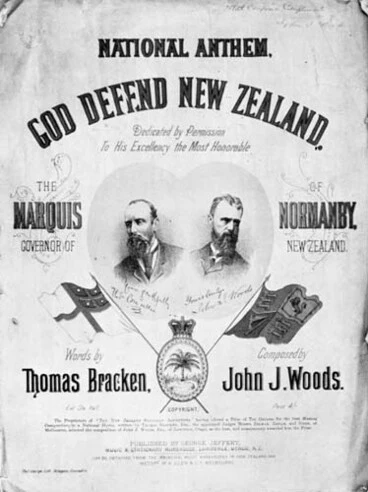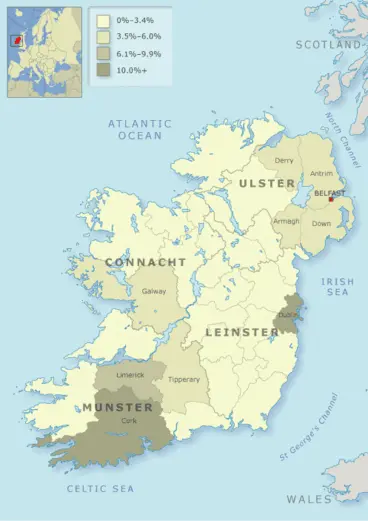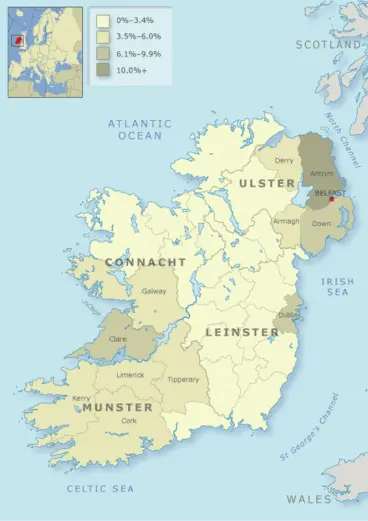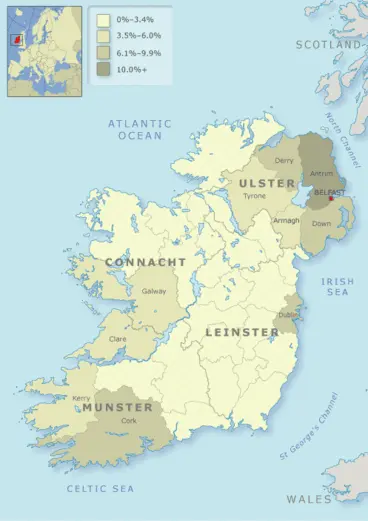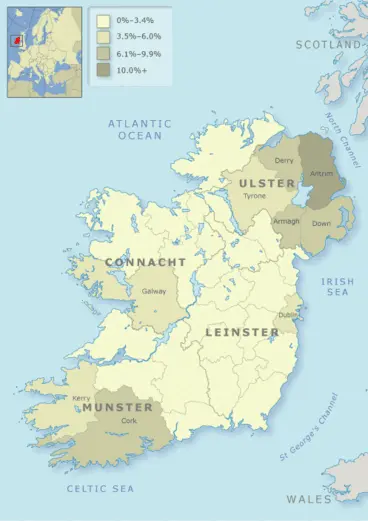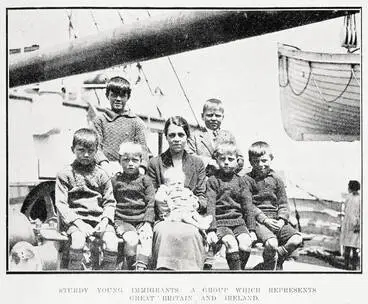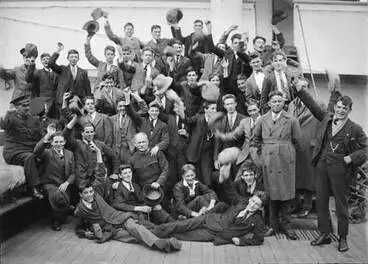Go green for St. Patrick's Day on 17 March!
A DigitalNZ Story by Zokoroa
The green of the Irish flag is the official colour for St. Patrick's Day, which is celebrated on 17 March.
St Patrick's Day, Saint Patrick, Holiday, Festivals, Irish, Ireland, Celebrations, Dancing
St. Patrick's Day: 17 March
St. Patrick's Day commemorates Saint Patrick, the Patron Saint of Ireland, who spread the word of Christianity until his death on 17 March 461 AD. Also called the Feast of St. Patrick, it is a cultural and religious celebration. In 1903, St Patrick’s Day became an official public holiday in Ireland. From 1878 until 1955, St. Patrick’s Day was also a public holiday in New Zealand.
Nowadays, St. Patrick's Day is also used to celebrate all things Irish with food, drink (usually Guinness stout), music, dancing, other forms of entertainment, and the wearing of green clothing and shamrocks.
The 17 March is also a special occasion for those whose birthday falls on this date. Happy birthday to your family and friends named Patricia, Pat, Patty, Paddy and Patrick, and to others born on this day! Enjoy your Irish pub breakfast and other activities - to be sure, to be sure! May the luck of the Irish be with you!
Upper Hutt Croquet Club members on St Patrick's Day
Upper Hutt City Library
St Patrick's Day at Upper Riccarton Library
Christchurch City Libraries
Irish singers
Kete Horowhenua
Greerton Irish Mile , Greerton Village, Tauranga, 2006 2003
Tauranga City Libraries
Greerton Irish Mile , Greerton Village, Tauranga, 2006 2002
Tauranga City Libraries
Irish dancers, 2000
Manatū Taonga, the Ministry for Culture and Heritage
RNZ (17 March 2022): Waikato Irish Society President John Davis explains history behind St Patrick's Day (7.25 min)
Radio New Zealand
Bring out your green for St. Patrick's Day!
The green of the Irish flag is the official colour for St. Patrick's Day. (See Wikipedia: Flag of Ireland.) The using of the colour green with Ireland had evolved over time since the colour blue was used by King George III after declaring the Kingdom of Ireland in 1542. He had created a new order of chivalry, the Order of Saint Patrick, and used the colour blue of the robe worn by Saint Patrick. During the 1780s, blue was adopted as the colour of the newly formed Anglo-Irish order of St. Patrick.
Why green:
Irish flag: In the 1640s the green harp flag was used by the Irish Catholic Confederation. Later in 1848, a tricolour flag – green, orange and white – was presented to the Irish nationalist leader Thomas Francis Meaghe of the Young Irelanders by a group of French women when he was visiting France. The colours symbolised the longed-for union between the Roman Catholics, represented by the green colour, and the Protestants who were followers of William of Orange, represented by orange, and peace between the two, represented by the white colour. Late in April 1916, both flags were flown during the Easter Rising between Irish republicans against British rule in Ireland with the tricolour more widely used. When the Irish constitution came into law later in 1937, the tricolour was confirmed as the official national flag of Ireland.
Green shamrock became Ireland's national symbol: During late 18th century, the Society of United Irish and other Irish militia began adopting the green shamrock (a three-leafed clover) as an emblem which led to it becoming a national symbol. Saint Patrick was said to have used the shamrock as a metaphor for the Christian Holy Trinity with each leaf representing the Father, Son and Holy Spirit. The three leaves are also said to symbolise faith, hope and love, whereas a four-leaf clover symbolises good luck. After the Acts of Union in 1800, when Ireland officially became a part of the United Kingdom, the shamrock was incorporated into the United Kingdom’s official royal coat of arms, alongside the English rose and Scottish thistle.
The shamrock - a three-leafed green clover - is Ireland's national symbol since 1800s
St. Patrick was said to have used the shamrock as a metaphor for the Holy Trinity – Father, Son & Holy Spirit
Christchurch City Libraries
Emerald Isle: Ireland also became known as the Emerald Isle due to its green countryside. Those words were first mentioned in a poem by William Drennan, entitled “When Erin First Rose” (1795).
Leprechauns: Green is also the colour of the Irish fairy called the leprechaun who is depicted as wearing a green hat and clothes. Folklore says wearing green makes you invisible to leprechauns who like to pinch anyone they can see. (See: National Geographic Kids: St. Patrick's Day.) If you catch one, legend also has it that you will be granted three wishes.
Ireland also became known as the Emerald Isle due to its green countryside
Those words were first mentioned in a poem by William Drennan, entitled “When Erin First Rose” (1795)
Canterbury Museum
Green is also the colour of the Irish fairy called the leprechaun who wears a green hat & clothes
Folklore says wearing green makes you invisible to leprechauns who like to pinch anyone they can see
Manatū Taonga, the Ministry for Culture and Heritage
St. Patrick's Day display
Kete Horowhenua
Irish colours at the Aotea Centre
Christchurch City Libraries
Gateway Bridge
Christchurch City Libraries
Control Tower at Christchurch Airport
Christchurch City Libraries
Chalk drawing, Sol Square
Christchurch City Libraries
Charlton's bar staff Robyn, Debbie and Jenny, dressed for St Patrick's Day.
Upper Hutt City Library
The Shamrock
Radio New Zealand
St. Patrick's Day celebrations
St. Patrick's Day was originally celebrated in Ireland with religious services and feasts in honour of St. Patrick. Gradually, St. Patrick's Day shifted from a religious observation to a secular celebration of Irish heritage. The earliest known St. Patrick’s celebration of Irish culture was held in 1600 by Irish immigrants in St. Augustine, Florida who also held a parade the following year on 17 March. Later in 1631, the Catholic Church established a Feast Day on 17 March honouring St. Patrick. Since 1903, St Patrick’s Day has been an official public holiday in Ireland. From 1878 until 1955, St. Patrick’s Day was a public holiday in NZ. Nowadays, it is a celebration of Irish culture throughout NZ without a day off work. You can search websites (eg Eventfinda and Allevents) to see what upcoming St. Patrick's Day celebrations have been promoted in various locations around NZ.
St Patricks day celebrations
Radio New Zealand
Mr J F Aspell flying the Irish flag on St Patrick's Day
Alexander Turnbull Library
Photograph - Two Irish coffee mugs with box
Te Toi Uku, Crown Lynn and Clayworks Museum
St Patrick's Day parade
Manatū Taonga, the Ministry for Culture and Heritage
St Patrick's Day at Warners Hotel
Christchurch City Libraries
Untitled [Guinness glass and coaster]
Museum of New Zealand Te Papa Tongarewa
Postcard with a bottle and cup of Guinness
Canterbury Museum
Brophy dancing an Irish jig
Auckland Libraries
The Irish jig brigade
Auckland Libraries
Dancers at the Irish National Feis, Kilbirnie, Wellington - Photograph taken by John Nicholson
Alexander Turnbull Library
An emblem of Ireland
Auckland Libraries
St. Patrick's Day celebrations in New Zealand
Auckland Libraries
Children dressed up for St Patrick's Day
Waimate Museum and Archives
St Patrick's fancy dress day
Waimate Museum and Archives
Celebrating St Patrick's Day
Manatū Taonga, the Ministry for Culture and Heritage
Irish sayings to use
For more Irish sayings, see https://irisharoundtheworld.com/irish-sayings/
IRISH SAYINGS. (Taranaki Daily News 18-5-1912)
National Library of New Zealand
Begorra or Begorah or Begorrah
Meaning: By God (e.g. It's a fine day, begorra"
National Library of New Zealand
“May the road rise up to meet you”
Meaning: May God remove obstacles in your journey through life
Hocken Collections - Uare Taoka o Hākena, University of Otago
Sláinte! (pronounced “slaan-sha”)
Meaning: Health. Used when toasting one another: “I drink to your health!”
National Library of New Zealand
"The jacks"
Meaning: The toilet (Likely a reference to Jack Power, who invented the first multiple cubicle toilet)
Christchurch City Libraries
"Was it any use?"
Meaning: Was it any good?
Alexander Turnbull Library
"Wear the leek"
Meaning: Symbol of Irish identity
National Library of New Zealand
Irish music to sing to & DAnce along with
Tape ("The Good Glass")
Puke Ariki
New Zealand Live - The Shenanigans
Radio New Zealand
The Rhythms of Ireland
Radio New Zealand
The sailor's hornpipe ; The Irish jig / [performed by] Pipe-Major James Patterson.
National Library of New Zealand
Traditional Irish banjo with Angela Usher
Radio New Zealand
works by Irish writers - SONGS, poems, plays & Books
You can also celebrate St. Patrick's Day by reading poetry out loud, enacting plays and reading novels by Irish writers.
Irish poem
Kete Horowhenua
Thomas Bracken was an Irish-born NZ poet, journalist & politician who wrote the words to NZ's national anthem
The first edition of 'God Defend New Zealand', for which Thomas Bracken wrote the words
Manatū Taonga, the Ministry for Culture and Heritage
Inventions & DISCOVERIES by the Irish
Irish inventions and discoveries include.
- John Gregg - Gregg Shorthand
- Robert Manning – Origin of the Manning Equation for describing water flow in channels
- Robert Boyle – Father of chemistry
- Francis Beaufort – Beaufort scale for indicating wind force
- George Boole – Boolean algebra.
- George Stoney – Introduced the idea of the electron
- John Tyndall – Why is the sky blue?
- Lord Kelvin – The Kelvin scale: Set “infinite cold” to zero.
For an overview of other inventions, see Wikipedia: Timeline of Irish inventions and discoveries.
Irish inventions and discoveries included Gregg Shorthand which was created by John Gregg in 1888
Museum of New Zealand Te Papa Tongarewa
St. PAtrick's Day moments Depicted by CartoonISTS
St. Patrick's Day. "Guaranteed LUCKY four leaf clovers." "I'll take the lot." 17 March, 2003.
Alexander Turnbull Library
Winter, Mark 1958- :Leap year joke - what do frogs wear on St Patrick's Day? ... 17 March 2012
Alexander Turnbull Library
ST. PATRICK'S DAY IN THE AFTERNOON, (Observer, 25 March 1905)
National Library of New Zealand
Find out more: Our Irish connection
Documentary (1999): Gary McCormick travels to Ireland to investigate "those strands which tie" Kiwis to the Emerald Isle
(8:09 min)
NZ On Screen
In 1840 Governor William Hobson named NZ's 3 provinces after regions in Ireland
Manatū Taonga, the Ministry for Culture and Heritage
1840–53 most came from the area around Dublin where several soldiers were recruited
Others came from the famine-stricken area around Munster in the south-west
Manatū Taonga, the Ministry for Culture and Heritage
1853-70: During the gold-mining era most came from South-East. Many were Catholics who'd initially gone to Australia.
Others came from County Antrim, near Belfast when Canterbury began to recruit Protestants from there
Manatū Taonga, the Ministry for Culture and Heritage
1871-90: Most came from Munster in the south-west
Increasing numbers from Dublin in the north-east were due to immigration agents in that area
Manatū Taonga, the Ministry for Culture and Heritage
1891-1915: Majority came from the counties around Belfast, in the north-east
Manatū Taonga, the Ministry for Culture and Heritage
1916-455: Increasing number came from the Protestant north
In 1921 the 6 north-eastern counties remained part of the UK as Ulster, while the rest of Ireland achieved independence
Manatū Taonga, the Ministry for Culture and Heritage
Graph of regional origins of Irish immigrants: 1840-1915
Manatū Taonga, the Ministry for Culture and Heritage
The Irish in New Zealand : historical contexts and perspectives
Howick Historical Village
The Irish Language Revival (New Zealand Tablet, 23 April 1903)
National Library of New Zealand
A treasury of Irish myth, legend and folklore
Howick Historical Village
After Imigration Act 1920, only those of British (including Irish) descent & Australians did not require an entry permit
Manatū Taonga, the Ministry for Culture and Heritage
Immigrants from Great Britain & Ireland, 1922
Auckland Libraries
Between WWI & WWII the majority of the immigrants were from the UK & Ireland
Manatū Taonga, the Ministry for Culture and Heritage
Katikati remembers its Ulster Protestant settlers in a series of murals on it's main street
C.4,000 Irish immigrants settled in Katikati & Te Puke following immigrant George Vesey Stewart arranging land grants
Manatū Taonga, the Ministry for Culture and Heritage
May the luck of the Irish be with you!
Find out more:
History.com: St. Patrick's Day, URL: https://www.history.com/topics/st-patricks-day
National Geographic Kids: St. Patrick's Day, URL: https://kids.nationalgeographic.com/celebrations/article/st-patricks-day
Wikipedia: Saint Patrick's Day, URL: https://en.wikipedia.org/wiki/Saint_Patrick%27s_Day



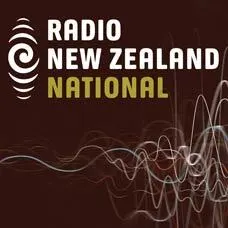



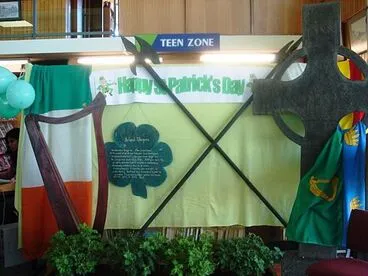




![[Postcard]. Erin! Oh Erin! Though long in the shade, Thy star will shine out, When the proudest shall fade. [ca 1912]. Image: [Postcard]. Erin! Oh Erin! Though long in the shade, Thy star will shine out, When the proudest shall fade. [ca 1912].](https://thumbnailer.digitalnz.org/?resize=770x&src=https%3A%2F%2Flive.staticflickr.com%2F5759%2F21636997486_4ec763d096_z.jpg&resize=368%253E)























